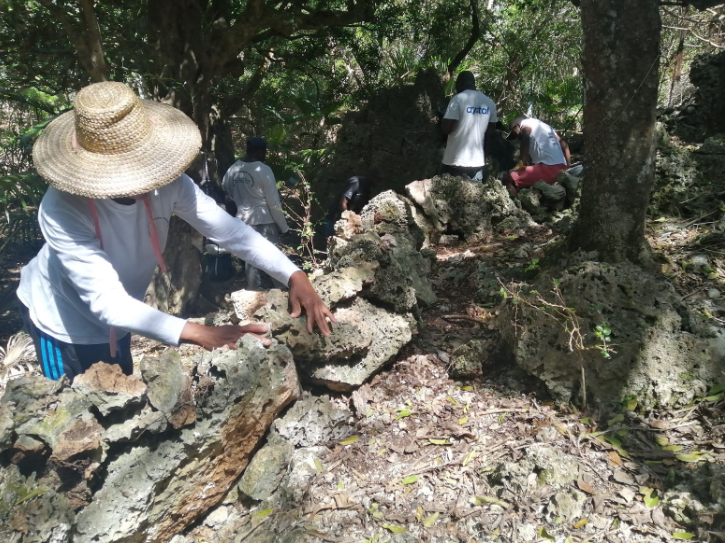Threatened trees in the Republic of Mauritius: The final stand of many species
-
Country
Mauritius -
Region
Africa -
Programme
Global Trees Campaign -
Workstream
Saving Plants -
Topic
Tree Conservation -
Type
Blog -
Source
BGCI
Blog published: 5 November 2021
There are many ways to go about restoration. From active management of land and species to passively allowing natural regeneration of the landscape to occur.

Passive methods can be better because they require fewer resources to implement and can lead to more natural ecosystems being formed, rather than even-aged plantations. As a result, they may be promoted as the best way for restoration to be done. However, when it comes to ensuring the most endangered species are included in restoration work, passively allowing ecosystems to return may not be that beneficial to their continued survival.

When natural regeneration fails
For some of the most threatened tree species, natural regeneration may not work. Climate change may have shifted phenological timing so that pollinators become out of sync with the plant; or human actions may have caused seed dispersers to go extinct – whether locally or globally. A species may also be dioecious with only male or female individuals left so that reproduction fails; or those individuals that do remain of monoecious species may be too widely dispersed in the environment to exchange genetic materials. Alternatively, introduced and invasive species might out-compete (if they are plants) or suppress the plants by consuming them (goats and rats for example).
In these situations, leaving nature to its own devices is not likely to save these species. Under these circumstances, at least some active efforts to conserve the species are needed. Research can help to understand how best to counteract the specific threats the species face. This may include how best to propagate the species – either sexual or vegetative – and how best to plant them back into the wild. Methods for controlling other, damaging species may be needed, as well as ways to protect the few remaining individuals from untimely fates, from adverse weather conditions or human development.
In these cases, assisted natural regeneration, lying in between passive and active restoration, may be key.
Global Tree Campaign project in Mauritius
Originating on a relatively recently colonised island, and like those of many other islands in the Pacific and Atlantic oceans, plant species on Mauritius (Indian Ocean) face all the challenges listed above. This has led to an incredible over 270 tree species being assessed as threatened on Mauritius and Rodrigues, despite the land mass making up just 2,040 square kilometres (for comparison, the US is 9.5 million square kilometres with roughly 380 threatened tree species). For many, they are down to the last few individuals, sometimes even down to the last one in the world or in the wild. The Global Trees Campaign, working with the Mauritian Wildlife Foundation (MWF), has been working on some of the most threatened of these since 2018.

Zanthoxylum paniculatum
The Critically Endangered Zanthoxylum paniculatum has only three individuals left on the island and none that produce any viable fruit. MWF has been monitoring these individuals for almost three decades, and in the past year has built retaining walls backfilled with compost to see if the added nutrients might increase the trees’ production of viable fruits and seeds. More recently, MWF has planted several native nitrogen-fixing Sophora tomentosa plants in the vicinity to also increase nitrogen levels in the soil. MWF has taken numerous air-layered cuttings to try to propagate clones that can be planted elsewhere in safe areas and has been attempting to graft cuttings on a Zanthoxylum heterophyllum tree planted in the Solitude Gene Bank.

This followed collaborative exchanges with Mike DeMotta, living collections curator and horticulturalist from the National Tropical Botanical Garden in Hawaii, where challenges with numerous other Zanthoxylum species have been overcome to bring collections into their gardens successfully.
Protection from airport expansion
On Rodrigues, to increase tourism and economic potential of the island, plans are underway to expand the small airport via the construction of a new runway. However, this will disturb some 115 native trees, including five individuals of four tree species that are currently on the brink: Foetidia rodriguesiana (Critically Endangered), Diospyros diversifolia (Endangered), Polyscias rodriguesiana (Critically Endangered) and Terminalia bentzoe subsp. rodriguesensis (Critically Endangered).
MWF is working closely with the local government (Rodrigues Regional Assembly), BGCI and the Naples Botanical Garden in Florida, to 1) propagate by seed, 2) clone and 3) transplant the trees to safer spaces before the development begins. Naples Botanical Garden has experience of transplanting whole trees successfully following damaging hurricanes, and so are advising on how best to do the transplantation. Plans are now in place for the coming eighteen months with an agreement already signed between the Rodrigues Regional Assembly and MWF (also acting on behalf of other local conservation organisations) to safeguard these rare plants.
These efforts should help MWF to keep these threatened trees, and more, alive for future generations, so hats off to these tree heroes. Read more about the project here.

Note: This article was co-authored with the MWF team, including Reshad Jhangeer-Khan and Dr Vikash Tatayah. Credit for the main story image of a Diospyros diversifolia tree scheduled for transplantation due to the airport expansion: Reshad Jhangeer-Khan/Mauritian Wildlife Foundation.
Written by Alex Hudson. Alex is managing plant conservation projects in Africa (Malawi and Uganda) and the Indian oceans (Mauritius and Rodrigues). He is interested in ethnobotany and the interactions between conservation and development at the local level.
Become a Member
Be part of the largest network of botanic gardens and plant conservation experts in the world by joining BGCI today!
Conservation Action Tracker
BGCI’s Conservation Action Tracker provides information on conservation actions for tree species.